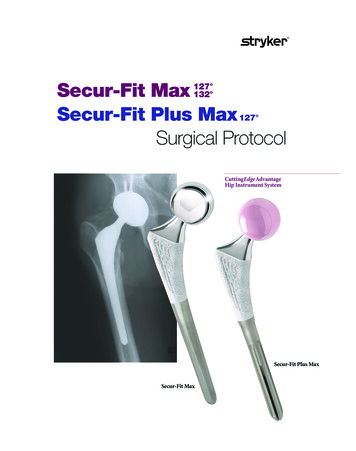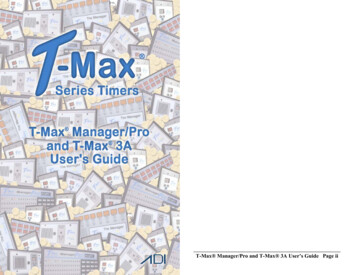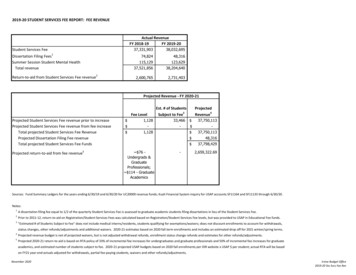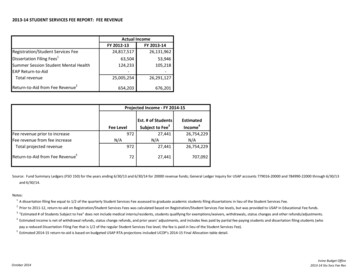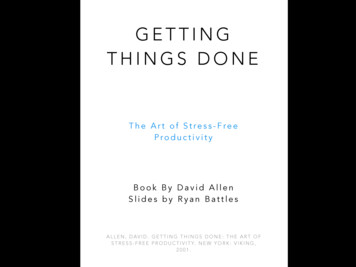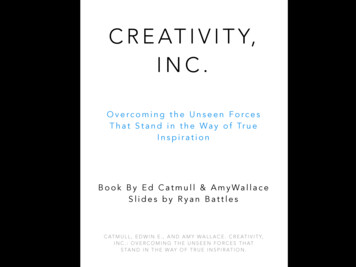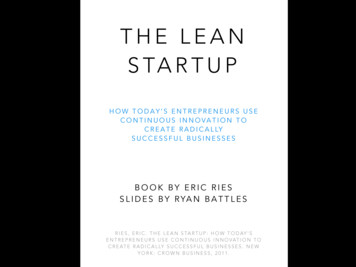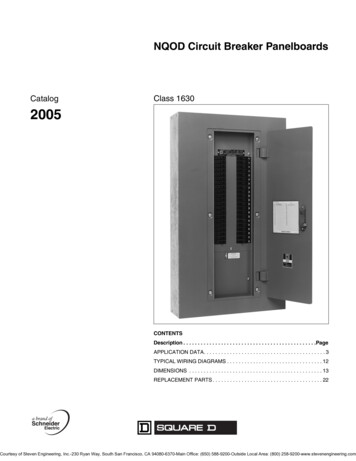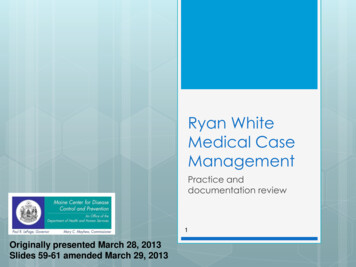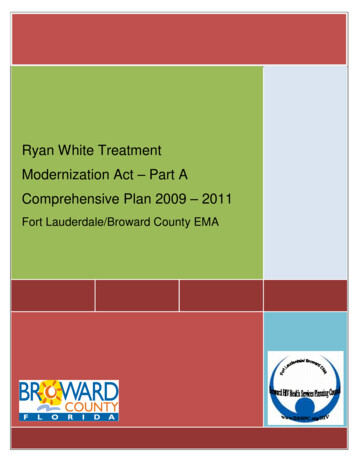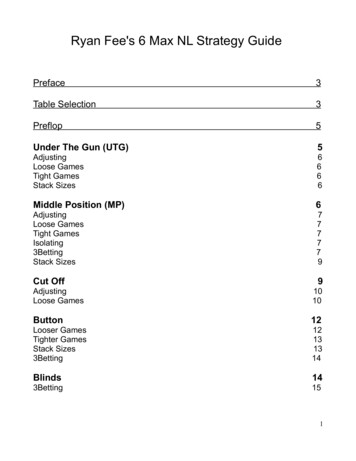
Transcription
Ryan Fee's 6 Max NL Strategy GuidePreface3Table Selection3Preflop5Under The Gun (UTG)5AdjustingLoose GamesTight GamesStack Sizes6666Middle Position (MP)6AdjustingLoose GamesTight GamesIsolating3BettingStack Sizes777779Cut Off9AdjustingLoose Games1010Button12Looser GamesTighter GamesStack Sizes3Betting12131314Blinds143Betting151
Squeezing15Ball Till You FallSqueeze IP: All Fucking Day1616Flop Play17Donk Betting (Leading)17Continuation Bettting18Loose/Bad s PFRFor ValueBluffsNot as PFRMonotone and Rainbow BoardsValuetown242425272728Unraised Pots28Dry BoardsHeavy Boards2829Turn Play29Double Barreling29Draws2 Pair or BetterOne PairIn Position303030Check Raising The Turn342
Floating The TurnRaising The Turn3536River Play39Triple Barreling39RaisingBluffing3939For Value41Mentality43Health43Upswings44Session Length44Multitabling44If you have received this PDF from any other source thandirectly from my website and would like to sign up to receive(for free) all the updates to this post, strategy videos, andother 6 max NL goodies please visit :http://www.ryanfee.comPreface3
This book will cover small stakes online 6 max ring games. All hands will be assumed to be 6handed, though other situations will be discussed. The focus of this book will be theprogression of a hand through preflop, flop, turn, and river.Your hand ranges in general should adjust and be contrary to the way the game is playing.This means that if the game is loose (meaning there are a lot of bad players, generallyplayers with VPIP's higher than 28, for example a player that plays 32/5/1 is a weak badplayer) you should be playing a tighter more solid game, bluffing less often (including semibluffs) and value betting thinly with 1 pair type hands. You should also play less startinghands.On the flip side if the game is tighter you should loosen up your starting range (incorporatinghands such as 65s UTG) to exploit the your opponent's tendency to fold. In these instancesyou should semi-bluff and bluff more, as you will find more fold equity.Loose players will search for an excuse to call, whereas a tight player will look for an excuseto fold.Table selectionWhen Table selecting you want to look for the following things: Players that play too many hands: Anything above 40 VPIP is gravy, but 30 is too manyhands as well. Also players that play something like 25/10 (meaning they arelimping/calling WAY too much preflop) will do as well Stack sizes: Generally you want players with full stacks to the right of you. You want tohave position on players that you cover, as it is EV. At the same time you wantplayers with short stacks to your left, as short stackers that have position on you are EV for you. In a perfect world you would play with 3 full stacks with VPIPs over 40 toyour right, and two tight short stackers to your left, but this will rarely ever happen, itsjust something to think about. Position and hands played: As described in the second feature for good gameselection you want loose players to your right and tight players to your left. Again thisisn't essential but its something to think about when switching/selecting seats, as wellas changing games. Losing/break even regulars: Your strategy should involve you playing 4 tables or lessand really focusing on your opponents while developing very strong reads. Feel free toplay with a regular that you have as a loser or marginal winner in your database. Avoidwinners. Your superior strategy will make it profitable to sit in a game with theseplayers and exploit them, so feel free to sit, just don't search them out or make a habit4
of it unless they are really bad. As a general guideline it is better to play at a table with a bunch of loose passive/weaktight type players than a table with someone who players 80% of their hands and 4other solid TAGs. For example I prefer a table with a: 40/10, 30/20, 25/14, 20/12, 17/12than a table with a 70/30, 23/20, 20/18, 20/18, 18/15. Its going to be easier to playagainst several bad/mediocre opponents that 1 very bad opponent and 4 good ones.“Poker is simple, as your opponents make mistakes, you profit.”Against loose/bad players you generally want to play straight forward tight solid poker.Against Tight/good players you generally want to mix up your play and play a more deceptivestyle. Do not make the mistake that every 20/17 multi tabling tag is tight AND good. Againstthese types of players you want to lean towards a looser pre-flop strategy and a solid postflopstrategy, as they will make mistakes for you, forcing them is not necessary.PreflopThis chapter is going to demonstrate preflop strategy and will focus on raising ranges, callingranges, and 3betting preflop (3B) (aka preflop reraise).Under the Gun (UTG)Being under the gun means that you have three players to act that hold position on you;middle position (MP), cut off (CO), and the button (BTN). It also means you have two playersto act that are out of position relative to you, the small blind (SB) and big blind (BB). Your UTGraising range should be the tightest of the four non-blind positions. Let's take a look at astandard preflop UTG range, assuming full stacks and a mix of tags/lag fish (players that playtoo many hands without purpose)/and loose passive (fish that check call and are easy toextract value from):Range: 22 (all pairs) ATs (meaning ATs, AJs, AQs, AKs) (s meaning suited) AJo (meaning AJo, AQo, AKo) (o meaning offsuit) 98s (meaning 98s, T9s, JTs, QJs, etc) KQo KQs5
KJs (KJs and Aqs [which was already covered]) (meaning suited 1 gappers)This will account for 13% of hands and is a conservative but very solid and profitable preflopraising range. Your UTG range can adjust based on the game quality you are in.AdjustingLoose games:Add hands like KJo or ATo, because you can make 1 pair type hands and extract value fromplayers calling with weaker top pair hands or second pair hands. The reason we typicallyavoid these type of hands in tight games is because we will frequently show up with secondbest 1 pair hands out of position (OOP) and will put us in tough spots and to lots of decisions.Always try to make poker easy to play.Tight Games:Include hands such as 65s or A5s. These hands have a lot of potential and will not often putyou into situations where you have weak 1 pair hands out of position. These hands widenyour range against likely better players and make you a more difficult and tricky opponent.Stack Sizes:You should also adjust your raising range based on stack sizes. For instance say you areUTG and there are two or three players with say 40BB stack sizes (or less). In this scenarioyou should avoid hands like 22-66 and 98s, and instead substitute in hands like KJo, QJo,A9s, ATo, because against these players you again are simply looking for a top pair type handto get it in against (These 40bb stack players will generally be very bad and play poorlypostflop getting it in with a wide range that doesn't include many top pair type hands)Though it should be made clear in the higher MSNL and HSNL (medium and high stakesgames) there are players who play a very tight and solid short stack game that are moredifficult to play against, however it is uncommon to encounter one of these players anywherebelow 3/6NL.Middle Position (MP)Being in Middle Position means that you will have one player to act in front of you (UTG)whom you have position on, two players to act behind you (CO and BTN) who have positionon you, and two players to act behind you (SB and BB) that you have position on. Middleposition is very similar to UTG. You will incorporate a few more hands, however all the sameprincipals apply. Again lets examine a standard preflop MP range, assuming full stacks and a6
mix of tags/lag fish (players that play too many hands without purpose)/and loose passive(fish that check call and are easy to extract value from): 22 (all pairs) A9s ATo 98s KQo/KJo/KQs/ KJs/KTsThis accounts for about 15% of total hands. Just like UTG this range can be manipulatedbased on the game quality.Adjusting:Loose games:You generally want to avoid things like A9o, as its potential is very small. Just like UTG youcan still profitably raise 98s and T9s, just do it less frequently.For example maybe you only raise these hands roughly half the time you are dealt them. Useyour image/table history to determine the optimal raising opportunity. For the most part in alooser game you want to keep things closer to the vest, so just simply raise less hands in thisposition.Tight Games:These games you can open up more from this position, include; 65s A8s, A5s QTsIsolating:Pending a very weak player, playing 40% or more of his hands, you need to keep in mind thatpeoples limping range UTG is as tight as it will get for them (even though it could be wide).You have to be careful about isolating in this position because there are two players withposition on you that understand you can isolate these players with a wide range. It is ok to tryto add a hand like J9s to your range here for the purpose of isolating a weak player (by weak Imean folding too much, whether it be limp folding, or to cbets/double barrels) however if youhave one or two tight aggressive opponents behind you that will exploit your extended rangeyou should err on the side of folding to avoid marginal situations.In the event that these players are in the blinds or you game selected well and you aren't at a7
table with opponents that go after you, sure go for it, isolate that limper.3 betting:In general you should be 3betting far more in position that OOP.The only person you can 3bet in MP is UTG. You need to be very cautious when 3betting anUTG opener, because this is where their raising range is likely the tightest (ignoring whenthey are in the blinds).Light 3bets are certainly profitable, however the ratio of light 3bet to value 3bet should beweighted heavily towards value. Lets say for number's sake we value 3bet an UTG opener80% of the time, and light 3bet 20%.First lets assign our 3bet range:Value: AKo/s Aqo/s (situational) Ajs (situational) KQs (situational) AA KK QQ JJ (situational) TT (situational)When I say situational I mean that it is possible that 3betting with these hands is marginal tothe point where you are not clearly ahead of their range. That doesn't mean you shouldn't3bet them, it just means you shouldn't do it every time and that you should be more inclinedto do it in position. A player that plays 14/12 and raises UTG probably raises the top 8% ofhands. The top 8% of hands looks like the following:88 ,AJs ,KQs,AJo ,KQoThe equity of these hands against this range are: AQ (all combinations) 48% AJs 41% JJ 54% TT 50% KQs 38%8
Whereas: AA 85% KK 72% QQ 63% AK 56%Light 3bet hands: 56s-QJs Axs (x should 5 most often, as you will be able to flop gutshot FD over typehands,but 4-T are all fine as well) 22-77 KQo AjoIt will generally be more profitable to call with small pairs preflop (as I will outline in post flopchapters) however they can certainly make their way into a light 3bet category every once in awhile. You generally want to 3bet an UTG opener with 56-T9s or Axs because with the SC'syou will generally avoid second best hands and have tremendous flop potential. The Axshands will block combinations of AA and AK (which will help avoid him 4betting you) and alsohave tremendous flop potential. Avoid all other hands as they will form second best handsoften and get you in marginal spots.Anyway, back to examining when to 3bet. We said we wanted to use an 80/20 ratio, 80 value,20 bluffs. This means for every 4 times you 3bet an UTG opener with something like AK orAA, you want to 3bet him once with 56s.Stack Sizes:Just like UTG you should also adjust your raising range based on stack sizes. As stacks getshorter this scenario you should avoid hands like 22-66 and 98s, and instead substitute inhands like KJo, QJo, A9s, ATo, because against these players you again are simply lookingfor a top pair type hand to get it in against (These 40bb stack players will generally be verybad and play poorly postflop getting it in with a wide range that doesn't include many top pairtype hands) Though it should be made clear in the higher MSNL and HSNL (medium and highstakes games) there are players who play a very tight and solid short stack game that aremore difficult to play against, however it is uncommon to encounter one of these playersanywhere below 3/6NL.9
Cut OffThis is where poker will become more interesting. The cut off is the first position consideredlate position and is a spot where you will more often than not be in position. There is a muchbigger transition in our range from MP to CO, as will be shown in our hand selection.The cut off is one of your most profitable positions, second only to the button. This position iswhere you will start isolating weak players that limp and 3betting players to keep the pressureon. Lets get to our range: 22 (all pairs) A5s A9o 65s JTo QTo KTo/K9s T8s (suited one gapers) Q9s (suited two gapers)Roughly 23% of total hands.The idea here is to steal blinds and isolate limpers. If you successfully steal someone's blindyou have earned 1.5BB's (big blinds). If you beat a game for 5 PTBB (poker tracker big bets,or two big blinds) you will notice that you earn .1BB per hand. That means that stealing blindsearns you 15 times the average profit per hand. Beginning to understand why it's so importantand profitable?AdjustingLoose games:Believe it or not, but playing from the CO in loose games is more tricky than tight games whenit comes to isolating. In a tight game you can raise anything and most decisions will be easy.In a loose game you run the risk of playing a lot of pots with marginal hands and (despitebeing IP) losing money.As you become better post flop you will have the capacity to raise more and more hands fromposition to isolate limpers, but first we have to exam
“Poker is simple, as your opponents make mistakes, you profit.” Against loose/bad players you generally want to play straight forward tight solid poker. Against Tight/good players you generally want to mix up your play and play a more deceptive style. Do not make the mistake that every 20/17 multi tabling tag is tight AND good. Against
